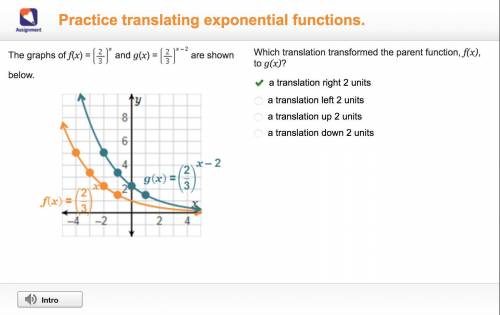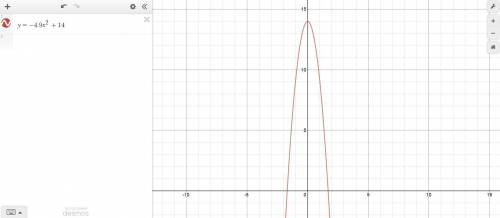 40
40 The answer is A. a translation right 2 units
I just took the assignment. see attached Picture

 40
40 The answer is A. a translation right 2 units
I just took the assignment. see attached Picture

 10
10  10
10  1
1  5
5 Problem 2
B) Shift 9 units to the leftIf we replace every x with x+9, then the inputs are now 9 units larger. This moves the xy axis 9 spaces to the right. If we keep the f(x) curve fixed in place while the xy axis moves, then it gives the illusion f(x) moves 9 units to the left.
Problem 3
B) Shift 1 unit downThink of f(x) as y. So f(x)-1 means y-1 to show that we subtract 1 from each y coordinate of each (x,y) point on f(x).
Problem 4
C) g(x) = 2f(x)We multiply each y value by 2. So g(x) = 2y = 2*f(x). This makes f(x) twice as tall as before.
Problem 5
B) shifted to the right 3 units and up 1 unitThe replacement of x with x-3 means we shift 3 units to the right. It's the similar idea to problem 2, but we're working in reverse now.
The +1 at the end means we shift 1 unit up.
 5
5 Problem 2
B) Shift 9 units to the leftIf we replace every x with x+9, then the inputs are now 9 units larger. This moves the xy axis 9 spaces to the right. If we keep the f(x) curve fixed in place while the xy axis moves, then it gives the illusion f(x) moves 9 units to the left.
Problem 3
B) Shift 1 unit downThink of f(x) as y. So f(x)-1 means y-1 to show that we subtract 1 from each y coordinate of each (x,y) point on f(x).
Problem 4
C) g(x) = 2f(x)We multiply each y value by 2. So g(x) = 2y = 2*f(x). This makes f(x) twice as tall as before.
Problem 5
B) shifted to the right 3 units and up 1 unitThe replacement of x with x-3 means we shift 3 units to the right. It's the similar idea to problem 2, but we're working in reverse now.
The +1 at the end means we shift 1 unit up.
 1
1  1
1  11
11 See explanation
Step-by-step explanation:
1. The function  represents the amount of profit Bill makes per toy when he increases or decreases the price of his handmade toys.
represents the amount of profit Bill makes per toy when he increases or decreases the price of his handmade toys.
The graph of this function is a parabola. The maximum profit is at the vertex of the parabola.
Find the vertex:

This means that decrease of 1 money unit (dollar, cent, euro,...) will give Bill the maximum profit of 4 money units (dollars, cents, euros,...)
2. The height, in feet, of the pebble over time is modeled by the equation 
The maximum height of the pebble is at parabola's vertex.
Find the vertex:

Thus, the maximum height the pebble can reach is 96 feet.
3. First, reflect across the x-axis the graph of the parent function  The reflection across the x-axis will give us the function
The reflection across the x-axis will give us the function 
Now, translate this function left 4 units and down 2 units to form the graph of g(x):

Open the brackets:

Hence,

4. The shape of the inside of a glass follows a parabola with the function 
The vertex of the parabola represents the bottom of the inside of the glass. Find the vertex of the parabola:

So, point (-3,0) represents the bottom of the inside of the glass.
5. The equation y = −4.9x2 + 14 represents the height y in meters of a rock dropped off a bridge over time x in seconds.
The graph of the function is attached.
6. First, reflect across the x-axis the graph of the parent function  The reflection across the x-axis will give us the function
The reflection across the x-axis will give us the function 
Now, translate this function right 5 units and up 1 unit to form the graph of g(x):

Open the brackets:

Hence,



It will provide an instant answer!
